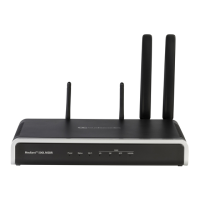User's Manual 47. Automatic Provisioning
Version 6.8 653 Mediant 500L MSBR
To enable this feature through the Web interface:
a. Open the Advanced Parameters page (Configuration tab > VoIP menu >
SIP Definitions > Advanced Parameters).
b. Under the Misc Parameters group, set the 'SIP Remote Reset' parameter to
Enable.
c. Click Submit.
To enable through CLI: configure voip > sip-definition advanced-settings > sip-
remote-reset.
47.2.5 Querying Provisioning Server for Updated Files
Each time the Automatic Update feature is triggered, for each file and its configured URL
the device does the following:
1. If you have configured the device to authenticate itself to the HTTP/S server for secure
access, the device sends the access authentication username and password to the
HTTP/S server (for more information, see Access Authentication with HTTP Server on
page 652). If authentication succeeds, Step 2 occurs.
2. The device establishes an HTTP/S connection with the URL host (provisioning
server). If the connection is HTTPS, the device verifies the certificate of the
provisioning server, and presents its own certificate if requested by the server. To
configure the certificate, use the CLI command, use-zero-conf-certificate. If set to yes,
the device uses the installed "Zero Conf" certificate (pre-provisioned during
production); otherwise, it uses the "regular" certificates (used for Web and SIP
applications).
3. The device queries the provisioning server for the requested file by sending an HTTP
Get request. This request contains the HTTP User-Agent Header, which identifies the
device to the provisioning server. The header is used for both the Automatic Update
and Zero Configuration features. By default, the header includes the device's model
name, MAC address, and currently installed software and configuration versions.
Based on its own dynamic applications for logic decision making, the provisioning
server uses this information to check if it has relevant files available for the device and
determines which files must be downloaded (working in conjunction with the HTTP If-
Modified-Since header, described further on in this section).
You can configure the information that is sent in the User-Agent header, using the
AupdHttpUserAgent parameter or CLI command, configure system > http-user-agent.
The information can include any user-defined string value or the following supported
string variable tags (case-sensitive):
• <NAME> - product name, according to the installed Software License Key
• <MAC> - device's MAC address
• <VER> - software version currently installed on the device, e.g., "6.80.200.001"
• <CONF> - configuration version, as configured in the ini file parameter,
INIFileVersion or CLI command, configuration-version
The device automatically populates these tag variables with actual values in the sent
header. By default, the device sends the following in the User-Agent header:
User-Agent: Mozilla/4.0 (compatible; AudioCodes;
<NAME>;<VER>;<MAC>;<CONF>)
For example, if you set AupdHttpUserAgent = MyWorld-<NAME>;<VER>(<MAC>), the
device sends the following User-Agent header:
User-Agent: MyWorld-Mediant;6.8.200.001(00908F1DD0D3)

